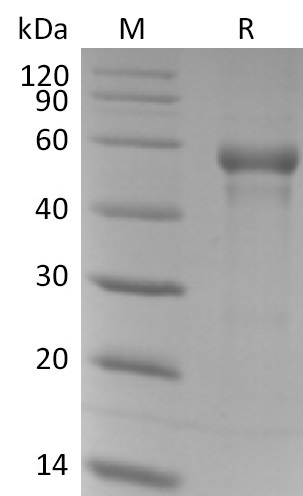- Remove All
 Your shopping cart is currently empty
Your shopping cart is currently empty
B3GAT1 Protein, Human, Recombinant (His)
B3GAT1 is the key enzyme during the biosynthesis of the carbohydrate epitope HNK-1, which is present on a number of cell adhesion molecules important in neurodevelopment. It adds a glucuronic residue to the terminal lactosamine residue (Gal beta 14GlcNAc) of a glycoprotein or glycolipid, which can be further sulfated to become the HNK1 epitope, a unique trisaccharide structure, HSO3-3GlcA beta 1-3Gal beta 1-4GlcNAc. The enzyme activity was found to be enhanced in the presence of sphingomyelin and phosphatidylinositol. The HNK1 carbohydrate epitope is characteristically expressed on a series of cell adhesion molecules in addition to some glycolipids in the extracellular matrix and on the cell surface in the nervous system, where it is involved in cell-cell and cell-substratum interaction and recognition during the development of the nervous system. Like most known glycosyltransferases, B3GAT1 is a type II Golgi-resident transmembrane protein with a short N-terminal cytoplasmic domain and a single pass transmembrane domain followed by an enzymatic domain in the lumen of Golgi apparatus. The enzyme activity was assayed using a phosphatase-coupled method.

B3GAT1 Protein, Human, Recombinant (His)
| Pack Size | Price | Availability | Quantity |
|---|---|---|---|
| 10 μg | $118 | 7-10 days | |
| 50 μg | $355 | 7-10 days | |
| 500 μg | $2,010 | 7-10 days | |
| 1 mg | $3,020 | 7-10 days |
Product Information
| Biological Activity | Activity has not been tested. It is theoretically active, but we cannot guarantee it. If you require protein activity, we recommend choosing the eukaryotic expression version first. |
| Description | B3GAT1 is the key enzyme during the biosynthesis of the carbohydrate epitope HNK-1, which is present on a number of cell adhesion molecules important in neurodevelopment. It adds a glucuronic residue to the terminal lactosamine residue (Gal beta 14GlcNAc) of a glycoprotein or glycolipid, which can be further sulfated to become the HNK1 epitope, a unique trisaccharide structure, HSO3-3GlcA beta 1-3Gal beta 1-4GlcNAc. The enzyme activity was found to be enhanced in the presence of sphingomyelin and phosphatidylinositol. The HNK1 carbohydrate epitope is characteristically expressed on a series of cell adhesion molecules in addition to some glycolipids in the extracellular matrix and on the cell surface in the nervous system, where it is involved in cell-cell and cell-substratum interaction and recognition during the development of the nervous system. Like most known glycosyltransferases, B3GAT1 is a type II Golgi-resident transmembrane protein with a short N-terminal cytoplasmic domain and a single pass transmembrane domain followed by an enzymatic domain in the lumen of Golgi apparatus. The enzyme activity was assayed using a phosphatase-coupled method. |
| Species | Human |
| Expression System | HEK293 Cells |
| Tag | N-6xHis |
| Accession Number | Q9P2W7 |
| Synonyms | β-1,3-glucuronyltransferase 1 (glucuronosyltransferase P),NK-1,NK1,HNK1,GlcAT-P,CD57,beta-1,3-glucuronyltransferase 1 (glucuronosyltransferase P),B3GAT1 |
| Amino Acid | His25-Ile334 |
| Construction | His25-Ile334 |
| Protein Purity | Greater than 95% as determined by reducing SDS-PAGE. (QC verified)  |
| Molecular Weight | 50-60 KDa (reducing condition) |
| Endotoxin | < 0.1 ng/µg (1 EU/µg) as determined by LAL test. |
| Formulation | Lyophilized from a solution filtered through a 0.22 μm filter, containing 20 mM Citrate, 8% Sucrose, 100 mM NaCl, 0.05% Tween 80, pH 6.0. |
| Reconstitution | Reconstitute the lyophilized protein in distilled water. The product concentration should not be less than 100 μg/ml. Before opening, centrifuge the tube to collect powder at the bottom. After adding the reconstitution buffer, avoid vortexing or pipetting for mixing. |
| Stability & Storage | Lyophilized powders can be stably stored for over 12 months, while liquid products can be stored for 6-12 months at -80°C. For reconstituted protein solutions, the solution can be stored at -20°C to -80°C for at least 3 months. Please avoid multiple freeze-thaw cycles and store products in aliquots. |
| Shipping | In general, Lyophilized powders are shipping with blue ice. Solutions are shipping with dry ice. |
| Research Background | B3GAT1 is the key enzyme during the biosynthesis of the carbohydrate epitope HNK-1, which is present on a number of cell adhesion molecules important in neurodevelopment. It adds a glucuronic residue to the terminal lactosamine residue (Gal beta 14GlcNAc) of a glycoprotein or glycolipid, which can be further sulfated to become the HNK1 epitope, a unique trisaccharide structure, HSO3-3GlcA beta 1-3Gal beta 1-4GlcNAc. The enzyme activity was found to be enhanced in the presence of sphingomyelin and phosphatidylinositol. The HNK1 carbohydrate epitope is characteristically expressed on a series of cell adhesion molecules in addition to some glycolipids in the extracellular matrix and on the cell surface in the nervous system, where it is involved in cell-cell and cell-substratum interaction and recognition during the development of the nervous system. Like most known glycosyltransferases, B3GAT1 is a type II Golgi-resident transmembrane protein with a short N-terminal cytoplasmic domain and a single pass transmembrane domain followed by an enzymatic domain in the lumen of Golgi apparatus. The enzyme activity was assayed using a phosphatase-coupled method. |
Dose Conversion
Calculator
Tech Support
Keywords

Copyright © 2015-2025 TargetMol Chemicals Inc. All Rights Reserved.


